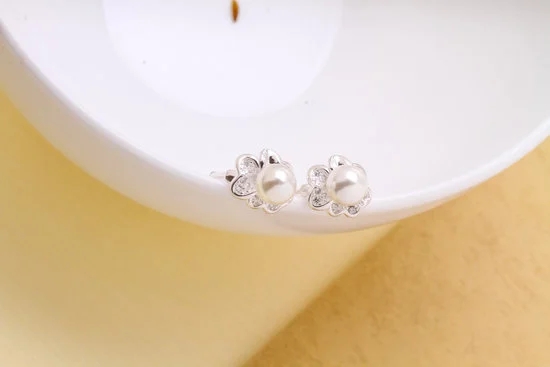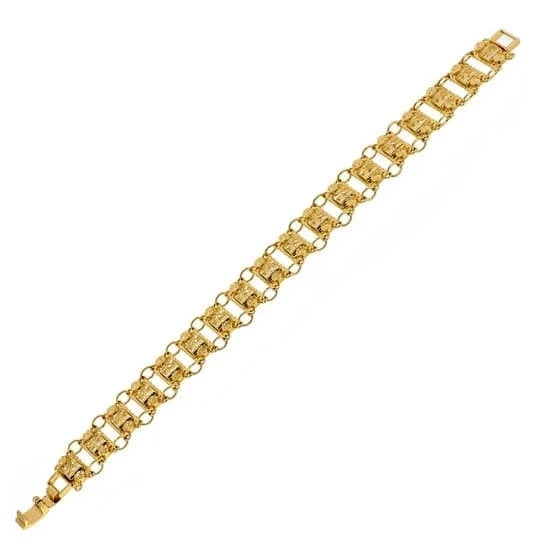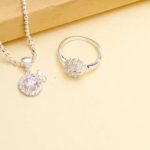The history of Brutalist jewelry is a captivating journey filled with unique artistic expressions and unconventional beauty standards. This distinctive style emerged as a rebellion against traditional norms, challenging the boundaries of conventional jewelry design. Characterized by bold geometric shapes, rough textures, and asymmetry, Brutalist jewelry became a reflection of the political, social, and environmental unrest of its time.
Brutalist jewelry finds its roots in the influential historical events and movements that shaped the art world. Drawing inspiration from Brutalist architecture, this jewelry style pushed the boundaries of what was considered beautiful and desirable. It sought to break free from the constraints of traditional materials and techniques, embracing unconventional mediums like concrete, steel, and non-precious metals.
From its peak in popularity to its subsequent decline, the trajectory of Brutalist jewelry mirrored shifting fashion trends and evolving consumer preferences. Over time, it faded into obscurity as minimalist designs dominated the scene. However, recent years have witnessed a resurgence of interest in this captivating style among artists and collectors alike. Contemporary designers are reinterpreting and reinventing the Brutalist aesthetic, breathing new life into this bold and unconventional genre.
Incorporating Brutalist jewelry into modern fashion allows individuals to make a powerful statement while embracing their unique sense of style. The versatility of this bold aesthetic offers endless possibilities for everyday fashion choices.
By exploring the timeless legacy of Brutalist jewelry, we can appreciate its enduring relevance in the world of fashion and art while celebrating its captivating allure. So join us on this journey as we delve into the fascinating history behind Brutalist jewelry – an exploration that promises to be both enlightening and inspiring.
Unveiling the Origins
Brutalist jewelry, with its bold and unconventional aesthetic, has a rich and fascinating history that can be traced back to the mid-20th century. The origins of this unique jewelry style can be found in the influential historical events and movements that shaped the art and design world at the time.
One significant influence on the emergence of Brutalist jewelry was the architectural movement of the same name. Brutalist architecture, characterized by its raw, unfinished concrete structures, gained popularity in the post-war era as a symbol of strength and resilience. This architectural style aimed to break away from traditional norms and challenge conventional ideas of beauty in design. The ethos of embracing rawness and imperfection resonated with jewelers who sought to create pieces that defied traditional standards.
Another important factor in the birth of Brutalist jewelry was a shift in artistic expression during this period. Artists were looking for new ways to push boundaries and rebel against traditional norms. They began experimenting with unconventional materials such as concrete, steel, and other industrial elements, translating the rough textures and geometric forms found in Brutalist architecture into wearable art.
Brutalist jewelry can also be seen as a reaction against mass-produced, uniform designs prevalent during the mid-20th century. It offered an alternative to mainstream jewelry styles by embracing asymmetry, irregular shapes, and unconventional techniques. By employing these unique design elements, artists sought to challenge established notions of beauty while creating pieces that were inherently individualistic and expressive.
The roots of Brutalist jewelry lie in a desire for artistic rebellion against societal norms while embracing materials and techniques that deviated from traditional jewelry craftsmanship. By drawing inspiration from contemporary art movements like Brutalist architecture and pushing boundaries in design, jewelers paved the way for an entirely new aesthetic that would leave a lasting impact on the world of fashion and art.
Breaking the Mold
When it comes to jewelry, society has long adhered to traditional conventions and perceived notions of beauty. However, the emergence of Brutalist jewelry in the mid-20th century challenged these norms and ushered in a new era of radical artistic expression. This section delves into how Brutalist jewelry broke free from the confines of traditional jewelry design, exploring its unconventional materials and techniques that sparked rebellion and defied expectations.
Brutalist jewelry pushed boundaries by employing unconventional materials such as rough concrete, industrial metals, and found objects. Artists sought inspiration from the rawness and imperfections found in everyday urban landscapes, transforming them into striking pieces of wearable art. In doing so, they deviated from the polished and refined aesthetic commonly associated with fine jewelry.
Techniques used in creating Brutalist jewelry further contributed to its rebellious nature. Artists embraced experimentation, utilizing unorthodox methods such as soldering metals together haphazardly or deliberately leaving visible tool marks on surfaces. These deliberate imperfections challenged conventional notions of craftsmanship while also adding an element of authenticity to the pieces.
One prominent figure who played a crucial role in breaking the mold of traditional jewelry was Robert Ebendorf. His innovative approach involved incorporating non-traditional materials like plastic bottle caps, bullet casings, and discarded fragments into his designs. Ebendorf’s creations were often asymmetrical, combining rough textures with bold geometric shapes that deviated sharply from the symmetry and intricacy prevalent in traditional jewelry.
The rebellion against traditional jewelry extended beyond just aesthetics; it also questioned societal norms regarding gender roles and self-expression. By embracing unconventional forms and materials, Brutalist jewelry provided individuals with an opportunity to define their own sense of beauty and identity outside the constraints imposed by mainstream fashion.
Overall, Brutalist jewelry revolutionized the world of adornment by challenging existing norms and redefining beauty standards. Through its use of unconventional materials and techniques, it broke free from the traditional mold of jewelry design, pushing the boundaries of what was considered acceptable in the realm of wearable art. In doing so, it opened up new avenues for self-expression and allowed individuals to make bold statements through their adornment choices.
Masterpieces of Brutalism
The Pioneers of Brutalist Jewelry
One of the most influential pioneers of Brutalist jewelry is undoubtedly Andrew Grima. Born in Italy and based in London, Grima’s unique designs captivated the fashion world in the 1960s and 1970s. His pieces often featured bold geometric shapes, rough textures, and unconventional materials such as rough-cut gemstones. Grima’s work blurred the line between sculpture and jewelry, redefining the notion of wearable art.
Another notable artist in the realm of Brutalist jewelry is Robert Goossens. Working primarily in Paris, Goossens gained recognition for his experimental approach to jewelry-making. He frequently incorporated organic materials like shells, coral, and stones into his designs, juxtaposing them with polished metals. This combination created a striking contrast that became a hallmark of Goossens’ work.
Innovative Techniques and Design Elements
Brutalist jewelry is characterized by its use of unconventional techniques that break away from traditional jewelry-making norms. For instance, artists often embraced irregularity and asymmetry, deliberately avoiding symmetry as a symbol of rebellion against established norms. They sought inspiration from raw materials found in nature, resulting in earthy color palettes and rough textures.
Furthermore, bold geometric shapes were prominent features within this style. Artists utilized angular forms such as triangles, squares, and hexagons to create visually arresting compositions. The juxtaposition of clean lines with rugged textures further emphasized the innovative nature of this artistic movement.
Noteworthy Design Contributions
One designer who made significant contributions to Brutalist jewelry is Bjӧrn Weckstrӧm. Based in Finland and known for his collaboration with the renowned Finnish brand Lapponia Jewelry, Weckstrӧm’s creations pushed boundaries with their sculptural quality. Inspired by elements from Finnish mythology and natural forms ranging from celestial bodies to rock formations, Weckstrӧm’s designs continue to captivate audiences today.
Another noteworthy figure is Caroline Broadhead, an artist who rose to prominence in the 1970s. Her jewelry pieces often incorporated non-traditional materials such as rubber and wire mesh, challenging the perception of what could be considered precious or conventional in jewelry design.
The masterpieces created by these artists and others in the realm of Brutalist jewelry epitomized innovation, rebelliousness, and artistic expression. Their designs challenged traditional notions of beauty and elegance, establishing a distinct aesthetic that remains influential to this day.
Cultural Significance
Brutalist jewelry, like any other art form, is deeply rooted in the cultural context of its time. And just as Brutalist architecture sought to challenge social and political norms, Brutalist jewelry served as a reflection of the turbulent society it emerged from. In this section, we will delve into how Brutalist jewelry mirrored the political, social, and environmental unrest of its time, and explore its connection with broader cultural movements and ideologies.
One of the defining characteristics of Brutalism as an architectural movement was its emphasis on rawness and honesty. Similarly, Brutalist jewelry rejected traditional notions of beauty and perfection in favor of embracing imperfections and unconventional aesthetics. This rejection of conventional norms aligned with the countercultural movements that began to gain traction during the mid-20th century. The rise of feminism, civil rights activism, and anti-establishment sentiments fueled a desire for personal expression that extended beyond societal expectations.
Brutalist jewelry became a canvas for artists to express their discontent with existing power structures and systems. It became a symbol of resistance against oppressive forces and vocalized marginalized voices.
Like the architecture it draws inspiration from, this style pushes boundaries by using unconventional materials such as rough metals, corroded surfaces, or uncut gemstones that are traditionally seen as flawed or imperfect. These choices were deliberate attempts to challenge mainstream definitions of beauty by highlighting the rawness and authenticity found within flaws.
Furthermore, Brutalist jewelry also aligned itself with broader environmental concerns present during its time period. The movement emerged amidst growing awareness about environmental degradation caused by industrialization and mass production. Many artists working in this style were conscious of these issues and chose to incorporate recycled or repurposed materials into their designs. By doing so, they not only created unique pieces but also made powerful statements about sustainability and the need for responsible consumption.
Brutalist jewelry thus served as both a visual record and commentary on the socio-political climate it existed in, capturing the collective consciousness of an era marked by activism, social change, and increasing environmental awareness. Its unique ability to fuse artistic expression with social critique made it a significant part of the larger cultural movements that shaped its time.
– Brutalist jewelry rejects traditional notions of beauty and perfection.
– The movement aligns itself with countercultural movements of the mid-20th century, such as feminism and civil rights activism.
– Artists incorporated unconventional materials and techniques to challenge mainstream definitions of beauty.
– Brutalist jewelry aligned itself with environmental concerns by using recycled or repurposed materials.
The Rise and Fall
During its heyday, Brutalist jewelry experienced a surge in popularity and captivated the fashion world with its unique aesthetic. However, like all trends, it eventually faced a decline in popularity. In this section, we will trace the trajectory of Brutalist jewelry from its peak in popularity to its subsequent decline, while examining the factors that contributed to its fall from grace.
At its height in the 1960s and 1970s, Brutalist jewelry was embraced by artists, designers, and even celebrities who were drawn to its bold and unconventional nature. The raw and unrefined appearance of these pieces resonated with those who sought to challenge traditional notions of beauty and self-expression. However, as fashion trends evolved and shifted towards more minimalist and delicate styles, Brutalist jewelry began to lose favor among consumers.
The decline of Brutalist jewelry can also be attributed to changes in consumer preferences. As society became more materialistic during the 1980s and 1990s, people started gravitating towards more precious gemstones and refined metals rather than the rough textures and industrial materials commonly found in Brutalist pieces. Additionally, advancements in technology allowed for mass production of jewelry at lower costs, leading to an influx of affordable yet less distinctive designs flooding the market.
Despite its decline in popularity during this period, Brutalist jewelry never truly disappeared. It continued to have a niche following amongst collectors and enthusiasts who recognized the artistic value of these pieces. Furthermore, the cyclical nature of fashion meant that eventually there would be a resurgence of interest in this unique style.
In the next section (section 7), we will explore how Brutalist jewelry has experienced a revival in recent years as contemporary designers reinterpret and reinvent this distinct aesthetic for a new generation of fashion-forward individuals.
Resurgence and Contemporary Influences
The resurgence of Brutalist jewelry in recent years has captivated the attention of artists and collectors alike. After a period of decline, this unique style is experiencing a newfound popularity and appreciation. In this section, we will explore the factors contributing to the revival of Brutalist jewelry and examine how contemporary designers are embracing and reinventing the Brutalist aesthetic.
Revived Interest: Exploring the Fascination with Brutalist Jewelry
Brutalist jewelry’s revival can be attributed to several factors. One significant reason is the growing interest in vintage and retro styles among fashion enthusiasts. As people seek out distinctive pieces that reflect their individuality, Brutalist jewelry offers a bold and unconventional aesthetic that stands out from mainstream designs.
Additionally, contemporary artisans and jewelry designers have rediscovered the artistic possibilities within Brutalism. These creative minds are drawn to its raw textures, unconventional materials, and striking geometric shapes, finding inspiration in the rebellious spirit it represents. By incorporating these elements into their designs, they offer new interpretations of Brutalism that appeal to a modern audience.
Contemporary Reinventions: Pushing Boundaries in Design
Contemporary designers are not merely replicating past Brutalist jewelry; they are pushing boundaries even further by experimenting with new techniques, materials, and forms. While retaining the core characteristics of brutality – rough textures, asymmetry, and geometric forms – they infuse their own unique vision into their creations.
One notable trend is the incorporation of sustainable materials into Brutalist jewelry designs. Recognizing the importance of environmental responsibility, many designers opt for recycled metals or ethically sourced stones while maintaining the rough-hewn aesthetic associated with Brutalism.
Another aspect that sets contemporary Brutalist jewelry apart is its versatility. Designers have found ways to make these bold statement pieces more wearable for everyday fashion, ensuring that they feel relevant to today’s style sensibilities. By reimagining scale, proportions, and lightweight materials, they create jewelry that is both visually striking and comfortable to wear.
Embracing Brutalism
Brutalist jewelry, with its bold and unconventional aesthetic, has become a captivating trend in modern fashion. Its unique characteristics, such as asymmetry, rough textures, and bold geometric shapes, allow it to make a statement and add an edgy flair to any outfit. If you’re looking to incorporate Brutalist jewelry into your own style, there are several tips and inspirations that can help you achieve a fashionable look.
Firstly, consider using Brutalist jewelry as the focal point of your outfit. Whether it’s a statement necklace, an oversized cuff bracelet, or a pair of striking earrings, let these bold pieces take center stage by pairing them with more understated garments. For example, a simple black dress or a white blouse and jeans can serve as the perfect backdrop to showcase the uniqueness of Brutalist jewelry.
Don’t be afraid to mix and match different styles of Brutalist pieces to create visual interest. For instance, combining chunky metal cuffs with sculptural earrings can add dimension and complexity to your overall look. Experiment with contrasting materials like concrete or wood alongside metals to further enhance the architectural influence of this style.
To complete your modern Brutalist-inspired ensemble, consider incorporating other elements that align with the aesthetic. Opt for minimalistic makeup with clean lines and neutral tones to complement the strong presence of the jewelry. Additionally, choose footwear and accessories that embrace simplicity rather than overpowering the overall look.
| Tips for Incorporating Brutalist Jewelry into Modern Fashion | Examples |
|---|---|
| Use Brutalist jewelry as the focal point of your outfit | A statement necklace paired with a simple black dress |
| Mix and match different styles of Brutalist pieces | Combining chunky metal cuffs with sculptural earrings |
| Incorporate contrasting materials alongside metals | Concrete or wood accents alongside metal jewelry |
| Opt for minimalistic makeup with clean lines and neutral tones | Natural-looking makeup that doesn’t compete with the jewelry |
| Choose footwear and accessories that embrace simplicity | Avoid overpowering the overall look with busy shoes or bags |
Conclusion
In conclusion, the history of Brutalist jewelry is a captivating journey that has left an indelible mark on the world of fashion and art. Throughout this article, we have explored the origins, rebellious nature, iconic designs, and cultural significance of this unique jewelry genre. We have traced its trajectory from popularity to decline and observed its recent resurgence in contemporary fashion.
Brutalist jewelry stands as a testament to the innovative spirit of artists who dared to challenge the conventions of traditional jewelry-making. By embracing unconventional materials and techniques, they broke free from the restraints of conformity and created masterpieces that pushed boundaries. The asymmetry, rough textures, and bold geometric shapes characteristic of Brutalist jewelry continue to captivate audiences today.
Furthermore, it is important to appreciate the cultural significance of Brutalist jewelry as a reflection of society during its time. This style emerged alongside a period marked by political and social upheaval, as well as environmental concerns. By mirroring these larger movements within their works, artists captured the spirit of activism and rebellion that defined their era.
While Brutalist jewelry may have experienced a decline with shifting fashion trends and evolving consumer preferences, its timeless legacy endures. Today, there is a renewed interest in the genre among collectors and contemporary designers who reinterpret and reinvent its aesthetic for modern audiences. The boldness and statement-making qualities of Brutalist jewelry make it an ideal choice for those seeking to make a striking fashion statement.
In conclusion, we encourage readers to explore and embrace the allure of Brutalist jewelry. Its distinct characteristics and artistic expressions continue to fascinate audiences even after all these years. By incorporating pieces into modern fashion or appreciating them as works of art, we can pay homage to this remarkable style that defied convention and left an indelible mark on the world of design.

Welcome to my jewelry blog! My name is Sarah and I am the owner of this blog.
I love making jewelry and sharing my creations with others.
So whether you’re someone who loves wearing jewelry yourself or simply enjoys learning about it, be sure to check out my blog for insightful posts on everything related to this exciting topic!





